The Importance of Pet Insurance: Protecting Your Furry Friend's Health and Your Wallet
Introduction:
We want the best for them, including top-notch healthcare when they need it. That's where pet insurance comes into play. In this article, we will explore the significance of pet insurance, its benefits, and how it can provide peace of mind for both pet owners and their beloved animals.
Why Pet Insurance Matters:
1. Financial Security
Just like humans, pets can fall ill or experience accidents that require medical attention. However, veterinary care can be costly, especially for complex procedures or long-term treatments. Pet insurance offers financial security by providing coverage for unexpected veterinary expenses. With a comprehensive policy in place, you can focus on your pet's well-being without the constant worry of mounting medical bills.
2. Comprehensive Coverage
Pet insurance policies can vary in coverage, but most plans include protection for accidents, illnesses, and even routine care options. These plans can cover a range of treatments, including surgeries, medications, diagnostic tests, vaccinations, and preventive care. By choosing the right policy, you can ensure that your pet receives the necessary healthcare without compromising on quality.
3. Peace of Mind:
Having pet insurance brings peace of mind to pet owners. Knowing that you have financial support in case of emergencies or unexpected health issues allows you to make decisions based on your pet's needs rather than financial constraints. This sense of security enables you to provide the best possible care for your furry friend, giving them a healthier and happier life.
How Pet Insurance Works:
Pet insurance operates on a reimbursement model. After enrolling in a policy, you pay a monthly premium based on the coverage and options you select. When your pet requires medical attention, you pay the veterinary bill upfront. Then, you submit a claim to your pet insurance provider, including all relevant documents and invoices. Once the claim is approved, you receive reimbursement for the eligible expenses as per the policy terms.
It's crucial to understand the details of your chosen pet insurance policy, including coverage limits, waiting periods, and any exclusions. Thoroughly reviewing the policy before enrollment ensures that you select the best plan for your pet's specific needs.
Choosing the Right Pet Insurance:
1. Coverage Options
Consider the specific coverage options offered by different pet insurance providers. Some plans focus on accidents and illnesses, while others may also include preventive care, dental treatments, or alternative therapies. Assess your pet's needs and choose a policy that aligns with their requirements.
2. Deductibles and Reimbursement Levels
Evaluate the deductible amount and reimbursement percentage of various plans. Deductibles are the out-of-pocket expenses you must pay before the insurance coverage kicks in. Reimbursement levels determine the percentage of eligible expenses that will be reimbursed. Finding the right balance between deductible and reimbursement can help you manage costs effectively.
3. Limits and Exclusions
Understand the limits and exclusions mentioned in the policy. These may include breed-specific conditions, pre-existing conditions, hereditary disorders, or specific age restrictions. Be aware of any waiting periods for coverage to ensure you have a clear understanding of what is covered and what is not.
Conclusion
Pet insurance offers pet owners peace of mind and financial security by providing coverage for unexpected veterinary expenses. By choosing a comprehensive policy tailored to your pet's needs, you can ensure they receive the necessary healthcare without compromising on quality. Make an informed






0 Comments